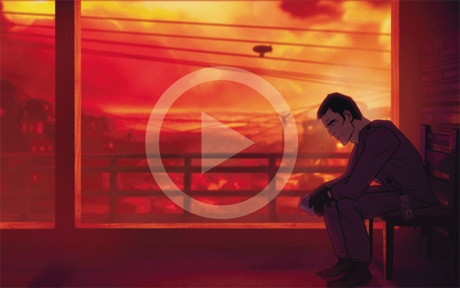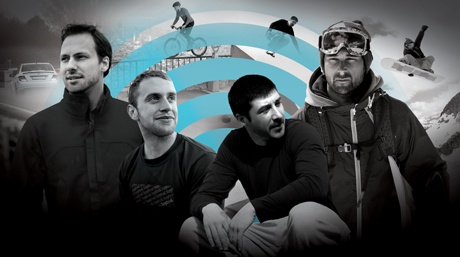Brands press play on web TV
Major brands are adding another layer to their digital marketing strategies by teaming up with big-name film and TV stars to produce original series for the web.

Electric City: science fiction web series created by Tom Hanks
The Fast Show, Crocodile Dundee and crime drama CSI are classic TV shows and films that millions of people are familiar with and able to exist partly because of advertising and product placement but now brands are going a step further and creating their own high-quality content.
However, the emerging format, usually brand-funded web series, is much more than simply long-form advertising: marketers are using big name producers to create work that consumers will love and want to watch, sometimes with little obvious involvement from the brand itself.
Cybergeddon
That includes web platform Yahoo!, which just launched its latest big budget series Cybergeddon,[1] about a cyber security breach on an apocalyptic scale. Hosted on the Yahoo! site and running over nine episodes, Cybergeddon was developed by Anthony E. Zuiker, the creator of TV crime drama CSI, with sponsorship from security software brand Norton by Symantec.
Although the concept offers Norton by Symantec a means of conveying the dangers of cyber crime in a new, engaging way, Dan Watt-Smith, Yahoo!’s head of video in the UK, says the series is also an independent piece of programming free from any explicit marketing by the brand.
“There are no product placement shots in Cybergeddon or conversations where people talk about how to download the latest security software,” he says. “It’s much more subtle than that. The brand simply provides the context that it wants to be associated with.”
Web-only animation
The launch comes after Yahoo! gained exclusive rights to show Tom Hanks’ web-only animation Electric City earlier this year. Watt-Smith says online is becoming a popular platform for original series because of the flexibility it offers brands and the talent alike.
“A lot of filmmakers and producers enjoy the creative freedom they experience in this environment,” he adds. “TV production studios and broadcasters take a very scientific approach to the process of creating a TV show whereas brands tend to be a lot more hands off. If the subject matter and the theme is something they’re happy to be associated with then brands tend to give a lot more creative freedom to the person they want to work with.”
The online platform opens up a host of interactive possibilities for Cybergeddon including character biographies, behind-the-scenes footage and social media feeds that are accessible alongside the main video. Norton by Symantec’s marketing is done as an adjunct to the series with click-throughs and sponsored articles that appear elsewhere on the Yahoo! site. The software company also worked closely on the development of the storyline to ensure its authenticity.
Andrew Ford, marketing director at Symantec, explains: “It was really important for us to emphasise how real the threat is. When it comes to the realities of cyber crime, we have built up a huge amount of knowledge over many years which our experts were able to share as the script was put together.”
Brand association
This idea of brand association is also central to the Foster’s Funny online platform. Two years ago, the lager brand began commissioning original comedy for the web when it revived the character of Alan Partridge for a series of short episodes. It proved a huge success, encouraging Foster’s to also commission new series of The Fast Show and Vic and Bob, while the Alan Partridge series was picked up by Sky Atlantic earlier this year.
Gayle Harrison, brand director at parent company Heineken UK, says the Foster’s Funny platform has helped to seal the brand’s association with comedy, as well as creating goodwill towards Foster’s for its pivotal role in reviving a number of much-loved characters (see Q&A below).
“Foster’s has been seen as a humorous brand going right back to the 1970s and our association with [Crocodile Dundee star] Paul Hogan,” she says. “We wanted to build an engagement platform around that in a way that was a bit surprising and would create some gratitude towards the brand for bringing to the audience something they wouldn’t otherwise have had.”
The ability of brands like Yahoo! and Foster’s to attract big-name talent appears to have had a huge impact on the response to their series. Foster’s, for example, reports that its online comedy content has so far received eight million views at an average dwell time of 10 minutes. “If you compare that with a 30-second TV spot, that length of engagement is phenomenal,” says Harrison.
Big-name talent
While Yahoo! has not disclosed figures about its series, an analysis of Electric City by research firm Brandwatch shows the pull of big-name talent. According to the research, 92 per cent of Electric City mentions on social media made reference to Tom Hanks.
By contrast, KFC’s original online comedy series Growing Up and Getting Out failed to generate much of a buzz on social media when it ran earlier this year. Brandwatch notes that by September the series’ five episodes had received only 19,000 YouTube views and that around 85 per cent of social media comments were neutral, meaning they did not show an emotional response from the viewer. This seems to reflect the low-key nature of the series: although it was produced by Comedy Central, the show used relatively unknown actors and simple sets.
Despite the muted reception, KFC insists it was still a worthwhile experiment. As part of efforts to promote the brand’s ‘grown-up menu’ the series focused on the rising number of young people who are forced to move back home to live with their parents. The brand also ran a social media contest alongside the series that asked viewers to share pictures and stories that expressed the humorous side of living at home with their parents. Five winners received ‘rent for the year’ in the form of $12,000 cash.
Rick Maynard, PR manager at KFC, explains: “We think branded web series can be relevant to multiple sub-groups in our audience, depending on how the content is executed. The insight behind Growing Up and Getting Out has significant appeal to young males but we also tried to make sure the content was relevant to other KFC customers by creating relatable situations and characters.”
Product placement
While Maynard insists that internal measures of the series have been “positive”, the low viewing figures suggest it failed to capture the audience’s imagination. Indeed the YouTube like/dislike bar shows a mixed response to the episodes, with some comments objecting to the quality of the programme and the KFC product placement.
Men’s grooming brand Remington seems to have had more success by trying a different tack. Rather than creating a generic TV series on a low budget, the brand’s Precision Pioneers series celebrates the niche area of adventure sports in four online films. The series, which was designed to promote Remington’s Touch Control shaving sub-brand, focuses on four different extreme sports people, including snowboarder Johno Verity and stunt cyclist Danny MacAskill (see Case Study below).
The short films boast high production values, including exclusive footage of each ‘pioneer’ in action and an interview in which they explain their approach to their craft. The Remington branding only appears at the start and end of the films, which were created by creative agency Addiction. Dominic Lewis, European brand manager at Remington, says the series has helped the brand to engage with its male audience while promoting the Touch Control values of power, precision and control.
“We know our consumers are really active online so we wanted to move away from the traditional media spend and target the consumer where we know they spend a lot of time,” he adds. “We wanted to create an emotional impact with the consumer and raise Remington brand awareness by developing content that tells a compelling story.”
Return on investment
The cult status of the pioneers and the exclusive nature of the footage seems to have generated a positive response. According to Lewis, the Danny MacAskill film received over 700,000 views in the three weeks after its launch, increasing Remington’s YouTube subscriber base by 32 per cent in the process. The popularity of the film has also translated into a tangible return on investment, with sales of the Touch Control beard trimmer on the Remington UK website up 100 per cent during the three-week period.
Measuring returns is also central to Gillette’s huge new investment in online programming. Building on its long history of sponsoring sport, the P&G-owned shaving brand last month launched the Gillette Football Club (GFC), YouTube’s biggest branded channel to date.[2]
This will form a hub for football videos across YouTube, with over 150 other channels contributing content including the various EMEA football broadcasters with whom YouTube already has deals. The channel will also host exclusive content such as entertainment and analysis shows created by production company Big Balls and interactive elements like statistics tool Squawka and social gaming platform Iamplayr.
Gillette communications manager James Williams says the move online is a natural progression for Gillette’s football sponsorship, which currently includes Sky’s flagship Soccer Saturday programme. “With broadcast TV, consumers have access to a plethora of live football and highlights shows but the online world of football is still hugely scattered,” he says. “The content is all over the place and you’ve got to go out and proactively search for it in order to find it. This provides a central hub for anyone interested in watching football online.”
By subscribing to the platform, users gain the ability to set preferences and tailor the content around the teams, countries and leagues they want to follow. Williams argues that this facilitates a completely new way of watching football. “It’s not in direct competition with live football on broadcast TV,” he says. “It’s about new content and the online experience.”
Engagement
P&G is aiming to attract a community of millions to the site, though Williams says the company will use a range of different measures to determine its overall success.”Yes it’s about subscriptions but it’s also about engagement,” he says. “So we’re interested in how much time guys are spending on the channel, their feedback and their input on the content. There’s also an extensive e-commerce plan built into this where you’ve got Gillette advertisements, content and links built around the channel too. There’s very much a business success measure behind this.”
Williams says there will be a “significant marketing push” to promote the GFC, from social media activity to banner adds elsewhere on YouTube. Yahoo! on the other hand shows its series exclusively on its own platform, allowing allows it to promote big budget series like Cybergeddon across all its other editorial output.
Dan Watt-Smith at Yahoo! says: “If you produce content and distribute it over a video sharing platform it’s up to the producer to promote it - there’s no policy around how the front page promotes content whereas we have our own front page. That’s the most important mechanism we have for communicating with an audience. We can then also cross-promote through our articles or with pop-up adverts in the other series that we show.”
Mobile-ready
Watt-Smith adds that mobile devices are becoming increasingly important to the spread of branded online series. Indeed with most series offering shorter, bite-sized episodes of around five to 10 minutes, the programmes are ideal for people who want a short burst of entertainment on the go.
Cybergeddon, for example, has been encoded in HTML5 to ensure it is mobile-ready. “There’s a ‘wow’ factor when you see something like this on an iPad compared to a desktop because all the interactive elements lend themselves to finger swipes,” says Watt-Smith. “The way in which you navigate through the experience is really iPad friendly.”
So in addition to providing content that customers truly value, brands must ensure they get their delivery models right when launching online series. Foster’s, for example, released a Foster’s Funny Facebook app earlier this to make it easier for people to view its original content. While this all adds up to a considerable investment by the company, brand director Harrison says it has been worth it.
“We know the comedy platform in its totality is really driving all our brand equity measures,” she says. “The brand has a huge amount of momentum behind it and our comedy output is a big part of that.”
Viewpoint

Dan Watt-Smith
Yahoo!’s head of video in the UK
With original online series Yahoo! generally acts as the digital distribution partner, though increasingly we’re getting involved in shaping the content too. So, rather than just being a neutral partner that provides the platform to deliver the content, we’re helping to shape it to ensure it fits in with what we’re doing elsewhere and that we’re happy to promote it.
A series like Cybergeddon is a particularly integrated approach because we’re looking at doing things in technology from an editorial standpoint. We already have a relationship with [software security brand] Symantec, which is sponsoring Cybergeddon, so with the series now launching we’ve pulled that all together with articles on our front page about online security, which is a big area of interest for Yahoo!’s audience.
A lot of filmmakers and producers enjoy the creative freedom they experience in this environment. TV production studios and broadcasters take a very scientific approach to the process of creating a TV show whereas brands tend to be a lot more hands off. If the subject matter and the theme is something they’re happy to be associated with then brands tend to give a lot more creative freedom to the person they want to work with.
In addition, those film producers and directors are really keen on the idea of being able to control distribution which they can never do if they work with a film studio or a broadcaster. So what appealed to [Cybergeddon creator] Anthony E. Zuiker and part of the whole pitch for this was the fact that there was a day and date release, meaning that the series was rolled out simultaneously around the planet.
That all ties in to the central creative concept behind the series, which is about somebody effectively crippling the planet because of a cyber bug they release. So the idea you can roll this out with a platform like Yahoo! and distribute it globally is something that a lot of directors love the idea of.
Q&A

Gayle Harrison
Brand director, Heineken UK
Marketing Week (MW): What was the initial thinking behind the Foster’s Funny platform?
Gayle Harrison (GH): We were looking for a platform area the brand could associate with. Beer brands typically have associations with sport or music but they’re quite busy and cluttered and also they are more traditional sponsorship. So we were looking for something different. We realised that comedy was a great platform area for Foster’s because humour has been part of the brand’s DNA for a long time.
MW: How did you develop the comedy association?
GH: We looked at the different ways we could play in the comedy area, ranging from traditional sponsorship to things you would think of more as engagement ideas. We were keen to do a bit of everything so we’ve got more traditional sponsorship in there: for example we sponsor all the comedy on Channel 4. That immediately gave the brand some scale in the comedy area. We also looked at how we could build an engagement platform, which led to us developing Foster’s Funny.
MW: Why did you choose to commission new comedy for the web?
GH: We knew our customers were watching a lot of content online generally and doing a lot of dual screening, which is why we looked at working online. In terms of the content itself, we decided to work with big names in the comedy world because we were just starting out and it was important for us to really associate ourselves with really good quality content.
MW: Was it difficult to get those names on board?
GH: We actually found it quite straightforward. Those names were looking for an opportunity to be creative and do something different. The way we’ve worked with everyone is to say we’re not here to have any kind of creative control - we’re not the comedians you are, you’re not censored. We just want you to do what you think the audience will really love. They told us they found that really liberating because they’d been able to do things that maybe they wouldn’t have been able to do if they’d gone to the more traditional channels.
MW: How did you promote the Foster’s Funny content?
GH: The biggest tool we used was actually PR because we knew we had some really great content and there was a great story behind the fact these programmes hadn’t been on TV for many years. The key thing for us was getting the talent on board and wanting to work with us to help us drive that PR. For example, Paul Whitehouse did a lot of work to promote The Fast Show series and Steve Coogan helped us with press releases to get the Alan Partridge show out there. They also filmed special clips for us that we could use to advertise online.
Case study
Remington

Grooming brand Remington launched its Precision Pioneers online series earlier this year to help promote its Touch Control sub-brand. The series, developed by creative agency Addiction, consists of four short videos that each focus on a different ‘pioneering’ sports person. These are snowboarder Johno Verity, F1 test driver Gary Paffett, Parkour founder David Belle and stunt cyclist Danny MacAskill.
Rather than pushing products, the series only features the Remington branding at the start and end of the films. The videos boast high production values, including exclusive footage of each pioneer in action and an interview in which they explain their approach to their sport.
Dominic Lewis, European brand manager at Remington, explains that the series aimed to provide consumers with exciting content and exclusive access to cult sporting figures. “We wanted to create an emotional impact with the consumer and raise Remington brand awareness by developing content that tells a compelling story,” he says. “In addition we want consumers to enjoy and share the content, generate buzz with journalists and bloggers and drive product sales.”
Remington’s own figures suggest the series has been a relative success so far. For example, sales of the Touch Control beard trimmer on the Remington UK website doubled in the three weeks following the Danny MacAskill film launch. Lewis also reports that the Daily Mail, Daily Mirror, Huffington Post, New York Daily News and ABC News all gave coverage to the film upon its launch and that over 88,000 Facebook users have viewed the video as a result of social sharing.
However, there are also huge differences in the number of views across the series’ different films. While the Danny MacAskill film is by far the most popular in the series with a total of over 700,000 views to date, the Gary Paffett film has received just over 2,000 views. This suggests that the existing popularity and profile of each pioneer has made a big difference to how the videos have been received.
By adopting a documentary style for its series, Remington has the option of adding more films to it as and when it adds to the Touch Control sub-brand with more products. Lewis suggests that by devising the series around the theme of “power, precision and control”, Remington has been able to position the Touch Control as a must-have for the modern male consumer.
He says: “A branded web series was a great fit because this particular target audience is highly engaged in online content and considers themselves well-groomed trendsetters who are quick to seek out and adopt new technologies.”
References
- ^ Cybergeddon, (cybergeddon.yahoo.com)
- ^ Gillette Football Club (GFC), YouTube’s biggest branded channel to date. (www.youtube.com)









